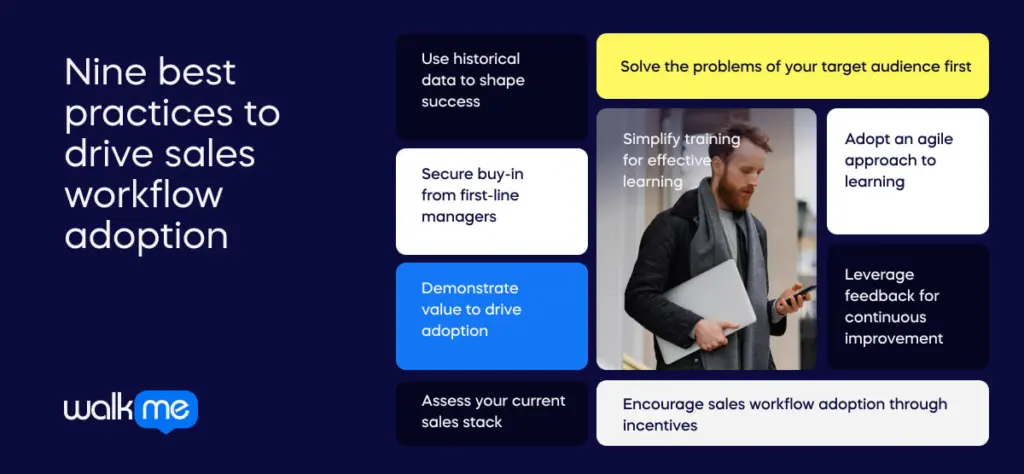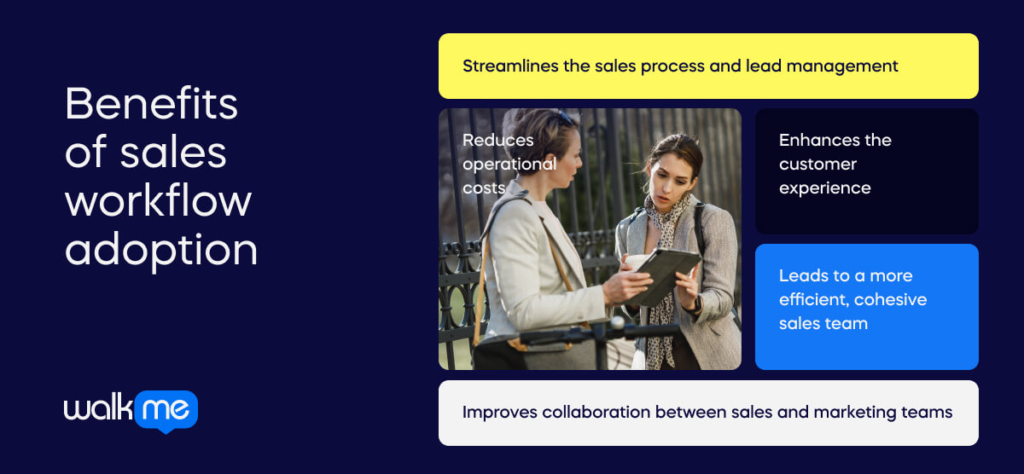Selling has evolved into a digital, data-driven effort. Digitally savvy customers expect quick, comprehensive responses and expertise. As a result, sales teams struggle to meet these high expectations.
Companies are investing in digital transformation tools to help their salespeople work efficiently. This improves their interaction with customers and delivers more value.
This includes using automation to end repetitive tasks. This will aim to increase sales and productivity.
However, the effectiveness of these tools hinges on whether the sales team uses them.
To ensure adoption, a clear plan is necessary. This plan will ensure sales teams use new workflows to drive revenue growth.
In this guide, we will explore:
- What sales workflow adoption is
- What its benefits and challenges are
- The best practices to ensure that your sales workflow adoption is successful
What is sales workflow adoption?
Sales workflow adoption occurs when sales employees understand how these tools can help them in their day-to-day roles.
A sales workflow involves creating processes to develop a lead for a customer from start to finish.
A successful sales workflow should focus on the customer and have clear steps. It must also let your sales team manage several leads at once and adjust to changes depending on your business or customer needs. Finally, it should include ways to measure success.
Automating these workflows allows sales reps to increase sales using different software tools with less effort.
This automation reduces manual tasks and helps create personal connections with important leads. For example, sales workflow software helps sales reps collect information on what leads like. This information can help direct them to useful sales content.
If a prospective customer goes to your website and downloads an item, the automation tool automatically puts them in your lead nurturing program. The tool then sends emails to encourage the lead to take more steps based on what they downloaded.
The tool can also guide them to customized messages that fit their needs. For instance, after downloading content, a lead might sign up for emails, try a free product, or ask for a meeting.
Depending on what the lead does, the sales tool can notify them through the system to take the next step.
Nine best practices to drive sales workflow adoption

The key to encouraging sales reps to embrace a new process lies in simplicity, honesty, and demonstrating how it benefits their sales efforts.
Here are effective strategies to boost sales workflow adoption among end-users and enhance sales results:
Solve the problems of your target audience first
Adopting new messaging strategies begins much earlier than many realize, rooted deeply in the initial stages of the sales workflow adoption process. This early stage, critical for setting the tone and direction, requires a blend of cooperation among sales team members, data insights, and diverse thoughts and experiences.
This mixture ensures that the developed messages engage potential customers effectively and resonate well within the team. By tackling this foundational stage using strategic change, leaders can preemptively address the sales workflow adoption challenges that might later evolve into significant obstacles.
This ensures a smoother transition and greater acceptance of new sales strategies.
Use historical data to shape success
One of a leader’s most powerful tools is the ability to analyze historical sales data. By reviewing past performances and making future decisions based on these insights, leaders can significantly enhance the likelihood of sales workflow adoption.
Sales teams are naturally more receptive to strategies supported by concrete, analytical research. Engage with team members early, especially when transitioning to or updating new systems. This ensures the messaging strategy is built on a solid foundation of proven success.
Secure buy-in from first-line managers
Adopting new processes critically depends on the support and buy-in from first-line managers. These individuals play a pivotal role in addressing any concerns or objections from the sales team. Managers who have succeeded in this area are typically well-informed and adept at handling challenging inquiries.
Their ability to consistently reinforce the importance of the new process and encourage their teams to strive for excellence is invaluable in driving sales workflow adoption. It also ensures that sales representatives are fully committed to the new strategy.
Assess your current sales stack
Understanding how each tool in the sales and marketing tech stack interacts is essential for driving sales automation. By mapping out these interactions, leaders can visualize the entire sales process from a technological standpoint. This then clarifies the expected interactions between sales representatives and the tools at their disposal.
This thorough mapping process identifies potential areas for improvement and helps streamline operations. This makes it easier for sales teams to efficiently guide leads through the sales funnel.
Demonstrate value to drive adoption
Highlighting the value and benefits of new processes or technologies is paramount for encouraging adoption among sales teams. Leaders must effectively communicate how these changes will make the sales reps’ jobs easier. But they also enhance their ability to close deals and meet their sales targets.
Demonstrating tangible outcomes and successes using the new sales workflow process can significantly influence the team’s willingness to embrace change initiatives.
Whether it’s showcasing improved sales win rates or reduced sales cycle lengths, clear evidence of the benefits can motivate the team to adopt the new strategies.
Simplify training for effective learning
The complexity of training can often be a barrier to adoption. Simplifying the training program can make new processes more accessible to the sales team. This can be done using clear and straightforward language, incorporating visuals or walkthroughs, or providing practical hands-on practice opportunities.
Investing in sales enablement professionals who specialize in making training content engaging and understandable can be a game-changer.
Adopt an agile approach to learning
Embracing an agile learning methodology allows for the continual development of sales skills through iterative, short bursts of training. This approach prioritizes practical, on-the-job training content and fosters a community of peer-driven learning.
Encourage sales workflow adoption through incentives
Offering incentives for adopting new processes or completing training programs can significantly enhance motivation and morale among sales representatives. These rewards, whether high-quality leads, additional PTO, or other benefits, transform the perception of training from a chore to a valuable opportunity.
Leaders can accelerate the sales workflow adoption process by setting an early deadline for training completion and offering incentives to meet it.
Leverage feedback for continuous improvement
Collecting and acting on feedback from the sales team throughout the adoption and onboarding process is crucial for refining strategies and addressing any issues. Creating an employee feedback loop allows the team to share their experiences. This helps leaders make iterative improvements to the process.
Assess employees’ use of the sales workflow system regularly. Then, ensure that training and development efforts align with the team’s needs, leading to more effective adoption.
Benefits of sales workflow adoption

In today’s ever-changing business world, sales teams must use every advantage to beat the competition.
Here are the specific benefits of adopting sales workflow tools:
Reduces operational costs
Through sales workflow software, businesses can significantly reduce their operational costs. This includes eliminating paper-based processes, reducing the need for physical storage, and lowering expenses associated with manual data entry.
This type of workflow also allows organizations to identify areas for process improvement and divide resources more effectively.
Streamlines the sales process and lead management
Sales workflow platforms allow teams to capture and organize customers based on various criteria, such as interests, location, or engagement level. This enables them to prioritize efforts on the most promising prospects.
In other words, sales representatives can focus more on selling than administration.
Enhances the customer experience
A well-integrated sales workflow system allows businesses to make data-driven decisions. Organizations can look at trends by analyzing customer data for a more targeted approach.
Additionally, sales workflow adoption allows prioritizing tasks based on predefined business rules, ensuring high-value leads receive the attention they deserve. This strategic approach leads to increased revenue.
It also enhances the customer experience through personalized communication. This leads to an improved customer satisfaction and loyalty.
Leads to a more efficient, cohesive sales team
Sales workflow tools can provide real-time visibility into sales operations. These tools provide real-time updates on task statuses and analytics for tracking performance.
Furthermore, customizable dashboards and collaboration tools enable team members to share information. This ensures everyone is on the same page and can address any bottlenecks or issues.
Improves collaboration between sales and marketing teams
The collaboration between sales and marketing is a two-way street, where both teams stand to gain invaluable insights from each other.
By working closely, these teams can share valuable insights and best practices, enriching the buyer’s experience from initial contact to the final sale. The process ensures a coherent, unified messaging aligning with their expectations and needs.
The marketing team can equip the sales team with knowledge, such as insights into ongoing marketing campaigns.
The sales team offers marketing a direct glimpse into the customer’s world. It can share information about buyer demographics and challenges encountered during sales. This knowledge exchange enhances both teams’ effectiveness and ensures strategies are grounded in real-world customer interactions.
This alignment helps reduce the length of sales cycles. In the end, this contributes to an increase in revenue margins.
Challenges of sales workflow adoption

However, sales workflow adoption can fail to occur as a result of these challenges:
Skepticism and resistance to change
When introducing new technology to a sales team, skepticism and resistance are common. This resistance often stems from team members being comfortable with their current methods. They could also doubt the proposed technology’s benefits.
Additionally, selecting a tool that doesn’t integrate well with the existing sales tech stack can create more problems than it solves.
This highlights the importance of securing employee buy-in and incorporating feedback during selection. Ensuring compatibility and ease of use can enhance the likelihood of successful software adoption.
This means engaging with your end user from the beginning is essential. Highlight the advantages of the new technology, such as increased productivity and improved client relationships.
No relevant sales workflow adoption training
A significant hurdle in adopting new technology is the perception that it complicates rather than simplifies tasks. When reps feel bogged down by complex systems, it’s a sign that the tool doesn’t align with their needs.
Addressing this issue requires providing tailored sales workflow training sessions. Personalizing training programs to meet individual needs can improve adoption rates and empower team members.
This type of sales workflow adoption training makes them more efficient and effective.
When the team sees firsthand how the new technology alleviates their pain points, they are likelier to adopt new sales workflows. This moment is crucial for cementing the technology’s role in your team’s daily operations and fostering a culture of continuous learning.
Does not fit In with the current sales infrastructure
Introducing a new process can benefit the company but may clash with the current sales methods. If it disrupts or hinders their routine, their performance might suffer. Adding extra steps to finalize a sale can slow them down.
Furthermore, if the new process doesn’t align with their existing workflow, they will need more time and effort to adapt. Every minute they dedicate to understanding, incorporating, and applying this new process detracts from their time spent on activities that help them close deals and make their own income.
Next steps for sales workflow adoption
Sales representatives prioritize their independence and the ability to tailor their job approach, especially when their performance directly influences their outcomes. They are often skeptical of changes proposed by individuals outside of the sales realm.
Adopting a new workflow within a sales team hinges on understanding this mindset. Transformational leaders recognize that sales workflow adoption unfolds over several stages. This means a continual focus on employee engagement and adoption.
For successful adoption, leaders must clearly describe and distinguish the new behavior from past practices, ensuring the team is ready and focused.
Then, they must explain the value of the new behavior to the salesperson, creating a willingness to adapt. They must support the salesperson through any challenges in adopting the new behavior, providing necessary accountability and support.
The secret to successful process adoption lies in sales leaders recognizing the adoption journey. They must stay closely involved and not assume that initial acceptance will automatically lead to full adoption.
Effective sales workflow adoption requires leadership that motivates the team toward new behaviors. It also involves management that clearly defines these behaviors and coaching that addresses any challenges faced during implementation.


